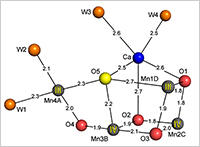Enlarge Image
Damage-free structure of photosystem II and the synthesis of model compounds for water-oxidation
Photosystem II (PSII) performs light-induced electron transfer reactions in photosynthesis, leading to the splitting of water into electrons, hydrogen ions, and oxygen, with which light energy from the sun is converted into chemical energy and molecular oxygen is produced to sustain all aerobic life on the earth. PSII is an extremely large membrane protein complex consisting of 20 subunits with a total molecular mass of 700 kDa for a dimer. The catalytic center for water-splitting is a Mn4CaO5-cluster organized as an asymmetric, distorted chair form embedded within the protein matrix of PSII.
The crystal structure of cyanobacterial PSII has previously been reported at a resolution of 1.9 Å using synchrotron radiation (SR) X-rays. However, due to the intense and continuous SR X-rays, the Mn4CaO5-cluster has been suggested to suffer from radiation damage, leading to slight changes in the inter-atomic distances within the cluster.
Now, a joint team led by Jian-Ren Shen at Okayama University, and Masaki Yamamoto and Hedeo Ago at the RIKEN SPring-8 Center, has solved the damage-free crystal structure of PSII at 1.95 Å resolution using the femtosecond X-ray free electron laser (XFEL) provided by SACLA, an XFEL facility located within the same campus of SPring-8.
The research group prepared a large number of highly isomorphous, high quality, large sized PSII crystals, and used the femtosecond XFEL pulses to collect diffraction data from a fresh volume of the crystals after illumination by each pulse. In this way, completely damage-free diffraction data was collected, allowing the analysis of the structure by the "diffraction before destruction" approach.
The structure obtained revealed the precise inter-atomic distances within the Mn4CaO5-cluster, enabling the mechanism of water-splitting to be examined in more detail. Based on the structure of the native Mn4CaO5-cluster, a research team consisting of scientists from the Chinese Academy of Sciences, Free University Berlin (Germany), and Okayama University (Jian-Ren Shen) has succeeded in synthesizing an artificial compound resembling to a large extent the structure of the native Mn4CaO5-cluster and exhibiting some distinctive characteristics of the native cluster.
These studies not only greatly advance our understanding of the mechanism of photosynthetic water-oxidation, but also are a large step forward towards the development of artificial photosynthesis that will ultimately provide us with a source of clean and renewable energy.
Reference1:
・ Authors: Michihiro Suga1, Fusamichi Akita1, Kunio Hirata2,3, Go Ueno2, Hironori Murakami2, Yoshiki Nakajima1, Tetsuya Shimizu1, Keitaro Yamashita2, Masaki Yamamoto2, Hideo Ago2, Jian-Ren Shen1
・ Title of original paper: Native structure of photosystem II at 1.95Å resolution viewed by femtosecond X-ray pulses
・ Journal, volume, pages and year: Nature 517, 99 (2015).
http://ousar.lib.okayama-u.ac.jp/metadata/53637
・ Digital Object Identifier (DOI): 10.1038/nature13991
・ Journal website: http://www.nature.com/nature/journal/v517/n7532/full/nature13991.html
・ Department website: http://www.gnst.okayama-u.ac.jp/index_e.html
・ Affiliations: 1Photosynthesis Research Center, Graduate School of Natural Science and Technology, Okayama University; 2RIKEN SPring-8 Center, 3Core Research for Evolutional Science and Technology (CREST), Science and Technology Agency (JST), Japan.
Reference2:
・ Authors: Chunxi Zhang1, Changhui Chen2, Hongxing Dong2, Jian-Ren Shen3, Holger Dau4, Jingquan Zhao1
・ Title of original paper: A synthetic Mn4Ca-cluster mimicking the oxygen-evolving center of photosynthesis
・ Journal, volume, pages and year: Science 348, 690 (2015).
・ Digital Object Identifier (DOI): 10.1126/science.aaa6550
・ Journal website: http://www.sciencemag.org/content/348/6235/690.full
・ Department website: http://www.gnst.okayama-u.ac.jp/index_e.html
・ Affiliations: 1Laboratory of Photochemistry, Institute of Chemistry, Chinese Academy of Sciences, China; 2College of Materials Science and Chemical Engineering, Harbin Engineering University, China; 3Photosynthesis Research Center, Graduate School of Natural Science and Technology, Okayama University, Japan; 4Department of Physics, Free University Berlin, Germany.

